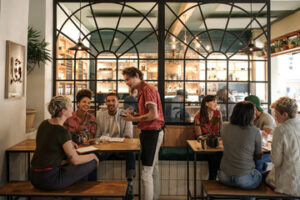A strong sense of community among campers can make for an unforgettable experience. However, one challenge that many camps face is adequate staff housing.
A new family housing complex opened at Camp Humphreys Thursday. The facility provides three-, four- and five-bedroom homes for service members and their families. It replaces the previous facility that was evicted from the neighborhood in April. Click the Man Camp Housing to learn more.

Staff members are the backbone of a camp and it’s important to have comfortable, safe housing. This can play an essential role in recruiting and retaining your staff as well as their overall satisfaction with their employment. The quality of staff accommodations can also have an impact on how well your staff is able to connect with and serve their campers.
The majority of our staff cabins are situated around our beautiful lake and are a short distance from our Parade Field, Handicraft Pavilion and the Adult “cabin”. These rustic structures offer both male and female staff accommodations and are equipped with electricity.
Each cabin is home to two or three counselors and eight to ten campers. Each group is assigned to a specific age range and session length. We take great care in ensuring that we honor cabinmate preferences and do our best to place staff with their friends and colleagues.
During your registration process, you will be asked to request your preferred housing options. These choices will help to determine your Grove (group) and, in turn, your cabin assignment. Please be sure to review our camp policies and select an option that reflects your role at EIC.
Program Staff are expected to manage a group of girls, teach them specific skills and be attentive to each girl’s safety. These tasks require a tremendous amount of responsibility, creativity and energy. They are also responsible for planning and executing evening programs and facilitating day-time activities. They are required to lead group discussions during rest hour and give nightly cabin devotions.
Program staff are housed in modern yet rustic, two-story lodges that have four separate rooms each sleeping six people. These lodges are located within walking distance of the main camp and have a bathroom in each room. Each lodge has a central air-conditioning unit, electricity and outdoor showers. These cabins are a great fit for today’s generation of young adults and provide the perfect setting to engage with campers and foster a positive and lasting impact on their lives.
Cabins for Senior-Level Staff
Camp Lebanon’s staff accommodations are designed to provide a comfortable home base for the program and operational personnel that make summer camp possible. Whether in simple cabins or more modern dorm-style accommodations, staff members enjoy the comfort of beds made up with clean linens, access to shower facilities nearby, and plenty of room to sit and rest before returning for an afternoon of activities with campers.
Summit staff come from all over the US and the world to work at our camp, offering a diverse range of talents, expertise and abilities in a broad spectrum of areas. We seek staff that are committed to providing a high-quality, safe, fun, and positive experience for our guests and that believe in our inclusive, human-centered approach to working with youth and special needs populations.
Most of our programming staff – like camp counselors and specialist instructors – sleep in the same cabins as our campers, in an all-gender arrangement. This means that boys who share the same bunk will be able to talk with a counselor of their same sex about their experiences at camp. We find this to be a huge benefit for our campers, as well as our staff.
All of our cabins are equipped with at least one ceiling-type light fixture and a separate floor or wall-type convenience outlet in each living area, including toilet rooms, laundry rooms and other rooms where people congregate. Light levels in these rooms shall be at least 20 foot-candles 30 inches from the floor, and in all other rooms at a minimum of 10 foot-candles 30 inches from the ceiling.
In addition to housing, Summit support and medical staff arrive at camp up to 2.5 weeks before all other staff for a logistical and technical orientation and to begin the physical set up of the facility. Waterfront and adventure program staff will also attend a week prior to general camp orientation to participate in an American Red Cross lifeguarding and ropes course certification course specific to their role.
In most cases, support staff live together in a bunk-style arrangement with 8-12 support staff members in one or more cabins. While these arrangements vary from wilderness cabins to modern college dormitories, most staff understand that they will live with one or more roommates during their contract.
Cabins for Programming Staff
Staff members are the heart of stayover camps and play a critical role in their campers’ experiences. Providing them with comfortable housing helps keep them on the job, and also encourages them to invest in the wellbeing of their team and their campers. Unfortunately, zoning restrictions and other factors can make it difficult for camps to provide adequate staff cabins. That’s why more and more camps are relying on SIP cabins to meet their needs, especially for senior-level, operational, and programming staff.
Structural insulated panels (SIPs) are a lightweight building material that can easily be shipped to camp sites. This makes it possible for even rural camps to add cabins to their facilities. And because SIPs are so airtight, the buildings can be heated and cooled without wasting energy. They also serve as a barrier against pests and critters.
The low cost and quick installation of SIP cabins allows camp directors to add them to their camp facilities in a matter of days, which can have a significant impact on the overall quality of staff housing. They can also be combined with other buildings to form larger units to accommodate groups of staff or families. This can reduce construction time and costs, as well as the need to add water and septic systems to individual cabin sites.
In addition to being energy-efficient, SIP cabins are highly livable for camping staff. They can be fitted with a full kitchen, bathroom, and living room. And since they’re built to be sturdy, durable, and aesthetically appealing, they can serve as permanent housing for camp employees.
Adding staff cabins with SIP construction can also help a camp increase the number of weeks it offers each summer. This means more opportunities for campers to discover new interests and stretch their imaginations in a safe and supportive environment.
When camp staff are happy with their accommodations, they’re more likely to return for future seasons. So be sure to ask your staff what they think about their housing! Then, use what they’re telling you to improve camp housing for your next group of campers.
Cabins for Operational Staff
As they are on the front lines of service, operational staff often work in very challenging environments and should be well-supported in their efforts to ensure campers have a good experience. This may involve training for specific tasks (such as setting up water pumps and registering new arrivals), and ensuring that staff have the necessary equipment to carry out their duties. It also includes encouraging and facilitating communication between staff and campers.
For example, a camp management agency should be able to facilitate coordination meetings that are effective by clearly communicating objectives, encouraging participation, sticking to the agenda, seeking commitments, closing discussions, and ensuring everyone is heard. This will help the agency build trust with all agencies and ensure that their programmes are well understood by the camp population.
The ability to communicate with the community is especially important when a camp management agency has responsibilities for programme delivery in sectors such as shelter, WASH and education. The agency should always keep the protection, dignity and integrity of displaced people at the centre of all activities. This requires it to be vigilant about monitoring whether agencies are adhering to agreed standards for the provision of aid and proactively address any issues that arise, including failing to attend or share information with coordination groups, which could lead to local tensions or the exploitation of displaced people.
Providing comfortable living quarters for a seasonal workforce can improve morale and increase productivity by eliminating employee commutes, reducing staff turnover and attracting a qualified workforce [1]. It’s also possible to customize cabins with amenities such as kitchens and bathrooms to create a more homelike feel that can be particularly helpful for international workers.
While man camps are most commonly used in oil boom hotspots like Texas, North Dakota and Alaska, they are also popular for construction crews and other teams that require temporary housing on remote job sites. They are also ideal for large events, such as concerts and sporting competitions, where a temporary worker village can be set up quickly to provide comfort for the workforce.








